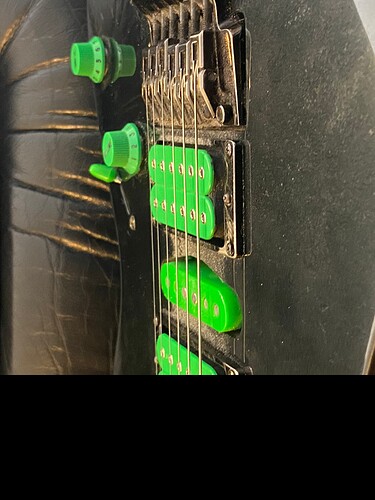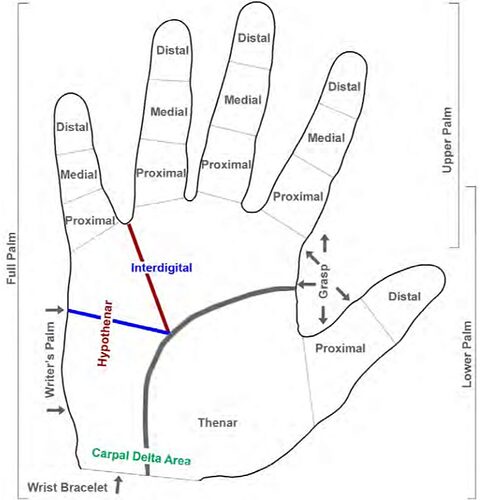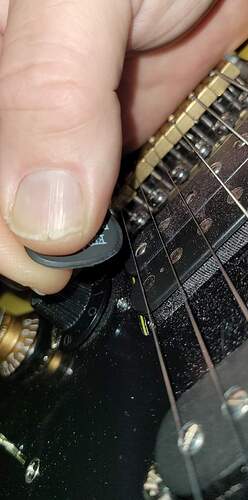Wondering if others find that some higher set floating trem bridges like the Ibanez edge make it more difficult to access/transition to lower strings smoothly? Seems exacerbated on my 7 string as well, but if I switch to my fixed bridge Kiesel of JEM with a lo pro it’s not so bad.I don’t have the same issues when playing USX/supinated
I use ibby’s with the original edge and don’t find it all that different. Ideally it should be set so that the saddlers are about where they should be on any other floyd and not so that you have a huge break angle, I also rest my hand to mute in the area between the saddle break point and the first pickup
Here’s what mine looks like:
I’m also a DSX player, and I honestly don’t notice.
I used to have issues but think I just moved my hand towards the neck a little more and it works great.
What do you mean by higher set? The bridge is physically higher from the body? Or the angle of the bridge?
I’m pretty sure they mean the fine tuners on a traditional type floyd getting in the way of their picking hand.
Yeah I think part of it is I tend to pronate when playing DSX runs, and so I anchor with the thumb part of my palm rather than the pinky side, and I’m trying to play Paul Gilbert Technical Difficulties/Scarified runs with palm muting, and it’s just not really conducive to that - I can sort of make it work but my hand wants to anchor on the body and transition to the bridge at the low end. I just need to figure out a comfortable way to do supinated DSX so I can mute with the other side of my hand. I’ve been messing with a few ways but they all feel a bit awkward.
Maybe I’ll dive into the PG’s actual hand positioning and see if I can figure it out. Or maybe the Andy Wood Masters in mechanics would help.
do a video man.
I think pronated wrist with the thumb brushing the strings is one of the only ways to do dsx anchoring on top of the bridge.
Though I might be totally misunderstanding what you’re saying lol.
Putting your hand forward helps with the muting a lot like @Judmeister and @Fossegrim said.
One thing I’ve tried that can help is putting your pinky flat either anchoring on the body or in the air.
I’m not a dsx player though so I don’t see another way besides doing this pinky thing or moving your hand forward. 2022 05 25 08 13 06 dsx muting - YouTube
I still am not sure how the bridge type changes it? You say
Thats not about muting? or is that what you meant?
I don’t have any answers to this as of yet. I find it particularly difficult as I anchor my thumb-side palm to the surface of the lower strings when playing at speed.
If anyone has any advice, I would love to hear it. It’s particularly frustrating because my main guitar I love playing is a Gibson 336 with a tune-o-matric bridge, which is obviously raised quite high from the body.
So would that add to the idea that the fine tuners are getting in the way as you said before? He’s really far back on the bridge in that.
The Gibson style has that drop off from the tune o matic to the string holder. That will allow the palm to rest lower than the string hight.
Paul mutes with the pinky side of his palm in the hypothenar region in the photo below in the location between the string break point and bridge pickup I described above.
This is more typical of USX players, but Paul rotates his hand towards the guitar just enough to pull off what are typically referred to as DSX lines. He actually uses somewhat of a rotational mechanic, along with the wrist translation but doesn’t quite DBX.
I can maybe show you what I believe he does later tonight after I get home. I patterned a lot of my playing after his a while back including his hand set up.
Also I’m not convinced that ibanez edge bridges are any higher than the typical floyded patented models. Their height and string angle should be exactly the same as any floyd really. The base plate is the only thing different, and that should really have no bearing on muting.
yeah, I think so. Although the tom type bridges have their own issue of being so far above the body that resting your wrist on only the bridge is somewhat required which takes some getting used to. I never liked them for the longest time till I tried a guitar that had a floyd after a few years of playing a LOW pro style and my picking hand was able to execute it. Note that instead of your wrist playing straight it would need to bend down towards the floor off the axis from the forearm slightly and this will accommodate the fine tuner issues I believe as well as moving the placement of the thumbside up towards the neck a smidge.



